(din ciclul Amintiri in timp despre…)
Nu-mi amintesc cu exactitate anul in care am vizitat cele trei capitale din Asia Centrala: Erevan, Baku si Tbilisi. Trebuie sa fi fost in a doua jumatate a anilor ’70. Am facut aceasta excursie de trei ori: o data singura (evident, cu un grupJ), si de doua ori cu sotul meu, cand am petrecut revelionul la Baku, respectiv la Tbilisi. De aceea, fotografiile pe care le veti vedea sunt facute fie toamna, fie iarna. Diapozitivele nu mai sunt in foarte buna stare, dupa atatia ani culorile incepand sa paleasca. M-am straduit sa aleg cele mai “bune” imagini, redandu-le de multe ori in sepia, pentru a va putea contura o parere despre niste orase acum foarte putin vizitate de catre romani. Pe nedrept, as adauga.
Aceasta calatorie se facea combinat, cu avionul, trenul si autocarul. Intre Tbilisi si Erevan – overland cu autocarul. Drumul dura cam 4 ore si ceva (cca. 50 km/ora), suficient pentru a mai atipi uneori. Cand deschideam ochii, nu rareori vedeam pe geam privelisti impresionante pentru ca soseaua traversa un pas inalt, intre munti. O oprire obligatorie se facea pe malul Lacului Sevan, lac artificial, care alimenta cu apa capitala.
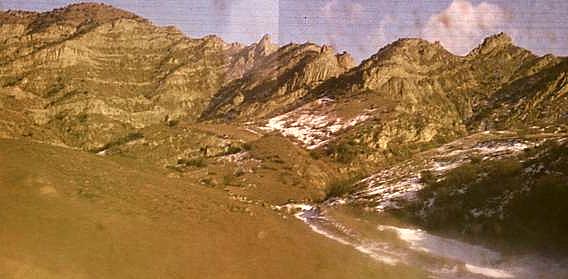 Pe teritoriul actual al Armeniei, intre secolele 9-6 inainte de Christos, exista statul Urartu. Regele sau, Argishti I, a construit in 783 inainte de Christos o fortareata, numita Erebuni, inaintasa orasului Erevan. In 2008, armenii au sarbatorit a 2790-a oara aniversarea sa. Cu alte cuvinte, Erevanul este mai vechi decat Roma!
Pe teritoriul actual al Armeniei, intre secolele 9-6 inainte de Christos, exista statul Urartu. Regele sau, Argishti I, a construit in 783 inainte de Christos o fortareata, numita Erebuni, inaintasa orasului Erevan. In 2008, armenii au sarbatorit a 2790-a oara aniversarea sa. Cu alte cuvinte, Erevanul este mai vechi decat Roma!
Asa cum ati aflat si in povestirile despre Uzbekistan si pe aici au trecut arabii (secolele 7-11), turcii selgiucizi si apoi otomani, persii. Orasul a fost distrus de mai multe ori in urma razboaielor, iar ceea ce a mai ramas a fost devastat de un mare cutremur, in 1679. La un moment dat in istorie, Erevanul devine obiect de disputa intre rusi, turci si persi, castigatorul fiind Rusia.
Erevan devine capitala a Armeniei in anul 1920. Pe atunci era numit Erivan, luind numele de Erevan abia in 1936. Arhitectul care ne-a lasat ceea ce vedem astazi, a fost Alexandru Tamanian. El a folosit in constructie tuful vulcanic de culoare roz, usor si estetic, bogatie naturala a tarii. De aici numele de “oras roz” al Armeniei, trebuie specificat, fiindca am mai vazut un “oras roz” la Jaipur, in India, nu? Capitala este asezata pe malurile raului Razdan si, in zilele senine, ofera privelistea mareata a Varfului Ararat.
Nu va pot povesti, pas cu pas, zilele petrecute in Erevan fiindca amintirile palesc si ele dar, ajutata de fotografii, va voi arata cam ce se poate vedea. Dupa cum mi-au demonstrat postari recente pe alte bloguri, orasul nu s-a schimbat esential.
In piata centrala, Piata Republicii, ramasa neschimbata dupa cate vad, se afla hotelul la care eram cazati, Hotelul Armenia. Tot aici, se poate vedea Turnul cu Ceas si Muzeul de Istorie Nationala. Piata foarte mare, rotunda, este locul din care pornesc mai multe bulevarde largi. Ea este ornamentata cu fantani, oaze de racoare in timpul verii, alaturi de numeroasele parcuri. Erevan era un oras destul de verde, chiar daca in unele locuri, copacii erau inca foarte tineri. Piata este, toata, roz!
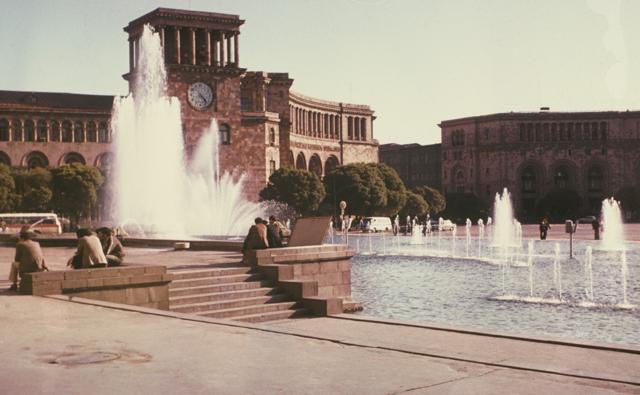 Piata Republicii, cu Turnul cu Ceas
Piata Republicii, cu Turnul cu Ceas
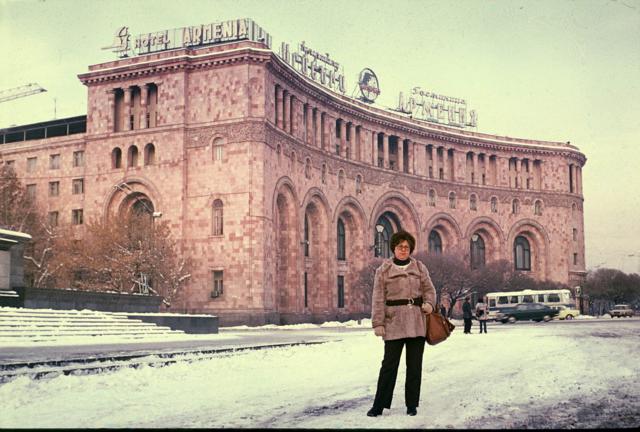 Hotelul Armenia si un soim mai tanar:)
Hotelul Armenia si un soim mai tanar:)
Nu departe, alte doua cladiri monumentale, Opera si Galeria Nationala. Pe unul dintre bulevarde te poti indrepta spre Cascada, un fel de parc care uneste centrul orasului cu Monumentul celei de-a 50-a aniversari a Armeniei Sovietice. Acesta este un obelisc de 50 m inaltime. Cascada a ramas neterminata. Pe vremea aceea, copacii abia fusesera plantati, deoarece constructia a inceput in anii ’70.
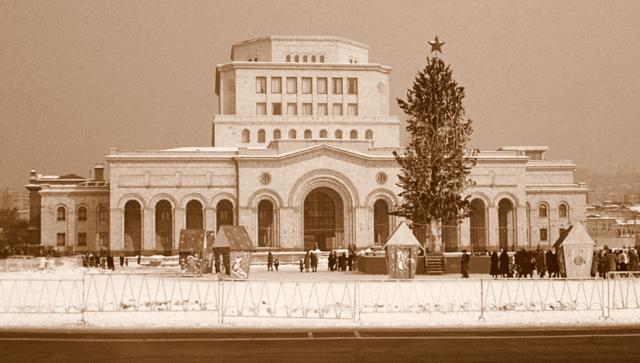 Galeria Nationala, in fata careia se afla un orasel al copiilor, unde acestia o asteptau pe Snegurocika, ajutoarea lui Marozii, echivalentul lui…Mos Gerila! Steaua sovietica, cu cinci colturi, trona in varful bradului.
Galeria Nationala, in fata careia se afla un orasel al copiilor, unde acestia o asteptau pe Snegurocika, ajutoarea lui Marozii, echivalentul lui…Mos Gerila! Steaua sovietica, cu cinci colturi, trona in varful bradului.
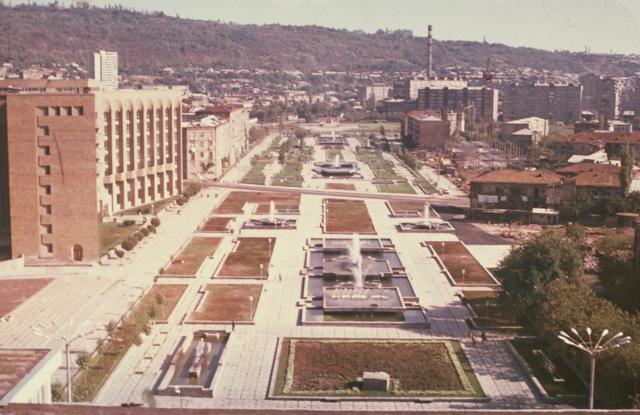 Erevanul vazut din partea de sus a Cascadei, un parc incipient atunci
Erevanul vazut din partea de sus a Cascadei, un parc incipient atunci
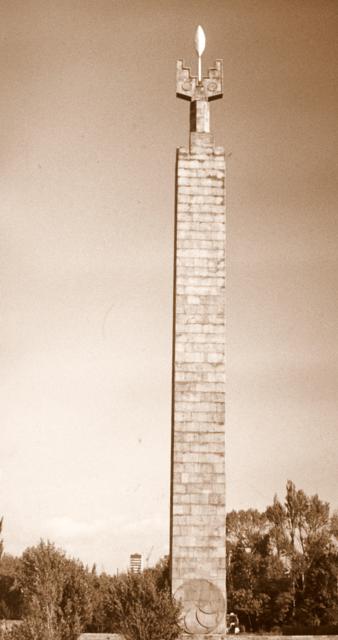 Monumentul celei de-a 50-a niversari a Armeniei Sovietice
Monumentul celei de-a 50-a niversari a Armeniei Sovietice
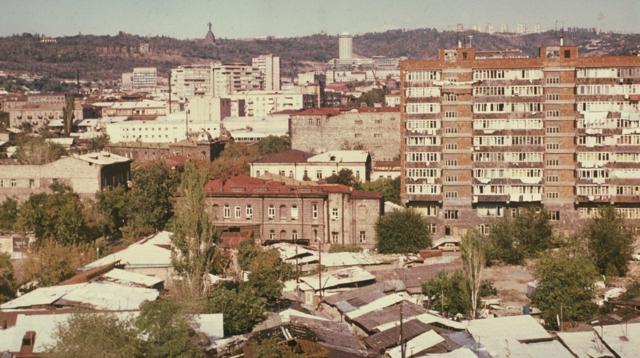 in ultimul plan, putin spre stanga, se poate observa o alta statuie de sorginte sovietica, Mama Armenia, reprezentata de o femeie cu o sabie in mana (36 m)
in ultimul plan, putin spre stanga, se poate observa o alta statuie de sorginte sovietica, Mama Armenia, reprezentata de o femeie cu o sabie in mana (36 m)
In fata garii din Erevan, statuia lui David din Sassun, calare pe al sau Dzalali, apara tara de dusmani. Opera a sculptorului Ervand Kochar, a fost dezvelita in 1959. Eroul popular David este un simbol al dragostei de libertate a armenilor. Legat de aceasta, un monument impresionant, aflat pe un deal, intr-un parc (fotografia nu e deloc buna dar n-am mai putut face nimic; am vrut totusi sa vedeti cum arata monumentul), Memorialul Genocidului, aminteste de cei 1.5 milioane de armeni masacrati de turci, intre 1915-1923. Complexul sculptural, inaugurat in 1967, consta dintr-un obelisc si 12 placi de bazalt, care sugereaza cele 12 provincii pierdute din Armenia de Vest. Imi amintesc foarte bine acest memorial, care m-a impresionat profund. Cele 12 placi protejeaza, la baza lor, o flacara vesnica, in jurul careia se afla mereu flori. Muzica solemna, grava, care rasuna continuu, are un impact emotional puternic.
Memorialul Genocidului
Ceea ce ar trebui sa vizitati neaparat, ar fi Institutul Manuscriselor Antice sau Matenadaran, cum este cunoscut de locuitorii orasului. Cladirea a fost construita in 1957, dupa planurile arhitectului Marc Grigorian. Numele de Matenadaran inseamna in armeana veche “magazin de manuscrise” sau “biblioteca”. Intr-adevar un numar mare de manuscrise foarte valoroase sunt pastrate aici, pentru studierea literaturii armene.
Trecand printr-un parc, un monument deosebit mi-a atras atentia: doua maini albe, din marmora de Carrara, simbolizeaza infratirea Erevanului cu acest oras italian. Se numeste pur si simplu Monumentul Mainilor.
In sfarsit, vorba cunoscutei sintagme “last but not least” (ultimul dar nu cel mai putin important), vizita nimanui la Erevan nu ar trebui sa se incheie fara a vedea o biserica. Si care ar putea fi mai potrivita decat Catedrala Echmiadzin, locul in care locuieste insusi patriarhul bisericii, numit Catholikos? Armenia este prima tara din lume care a introdus crestinismul, ortodoxia orientala, in anul 301. Catedrala a fost construita intre 301-303 si este cel mai mare centru religios al Armeniei.
Inca o data, imi cer scuze pentru calitatea fotografiilor dar, va rog, fiti indulgenti! Abia invatam sa folosesc aparatul de fotografiat si, dupa cum se vede, nu prea stiam sa incadrez o fotografie. Priviti-le mai mult pentru valoarea lor, devenita deja, documentara:)
Yerevan, “The Pink City” of Armenia
(of the series Time Travels in…)
I want to say, right from the beginning, that I am sorry for the quality of the photos in the next 3 posts. As I said, I digitalised slides which are more than 40 years old and already the colors are faded, so I preferred sepia for some of them. I also was at the beginning of my way on the road of photography, and I had little experience in this field. Please look at them for their documentary value, more.
I can’t recall exactly when these travels have been made. It was in the ‘70s and I visited the capitals of the three countries in Central Asia ( which still belonged to the Soviet Union by then), three times, in different seasons. The first time I was alone, in a bigger group of tourists, then I went with my husband and we celebrated New Years Eve in Baku and Tbilisi.
The transport was combined: by flight, by train, and overland by bus from Tbilisi to Yerevan. The travel lasted aprox. 4 hours, sufficient for a little nap. From time to time I was awake and saw beautiful, high mountains, covered with snow on the top. We also stopped near the Lake Sevan, an artificial, big lake from were the city of Yerevan took the water.
During the 9th.-6th. centuries before Christ, the Urartu state was founded on the actual territory of Armenia.The King Argishti I built the fortress of Erebuni in 783. This became Yerevan, which is older than Rome! As in the case of Uzbekistan, here too the arabs, the selgiucid and ottoman turks, and the Persians conquered and destroyed, and finally a big earthquake (1679) devasted what remained of the city. At a certain moment of the history, Yerevan became the motif of war between the Russians, Turks and Persians. The winner was Rusia. Yerevan became the capital of Armenia in 1920. At the beginning it was named Erivan, and became Yerevan in 1936. The main modern architect of the city was Alexander Tamanian. He used the pink lava turf as construction material, so the whole city became pinkish, hence the nickname of “the pink city”. Remember that I saw another “pink city” in Jaipur, India? Yerevan is on the banks of Razdan river and in the clear days offers an amazing view toward the Mount Ararat.
As I saw on more recent blogs, Yerevan didn’t change much. Helped by my slides I can show you some of the main objectives there. The center of the city is the Republic Square, adorned with a lot of fountains. Among the important buildings there are the Armenia Hotel (our accommodation), The Clock Tower and the Museum of History. Not far away, is the Opera and the National Gallery. On radial roads one can visit different other points of interest, like the Cascade, which connects the center with the Monument of the 50th Anniversary of Soviet Armenia, which is a 50 m high obelisk. Both remained unfinished.
David of Sassun, the statue in front of the railway station, represents the national folk hero, who fought to protect his country, becoming the symbol of the peace and freedom aspirations of the Armenian people. The statue was erected in 1959 and the author is Yervand Kochar. Another impressive place, up on a hill, is the Genocid Memorial, built in 1967. It reminds on the 1.5 millions of Armenians, massacrated by the Turks between 1915-1923. An obelisk and 12 basalt slabs remind on the 12 lost provinces of Armenia. An eternal flame and the continuous solemn music have a deep impact on the visitor.
Last but not least, the traveler has to see at least one church. I must say that Armenia is the first country which adopted the Oriental Orthodoxy, in 301. Echmiadzin is the place of the cathedral, the most important of the Armenian orthodox churches, the site of the Catholikos, who is the patriarch of the Armenians.It was build between 301-303.

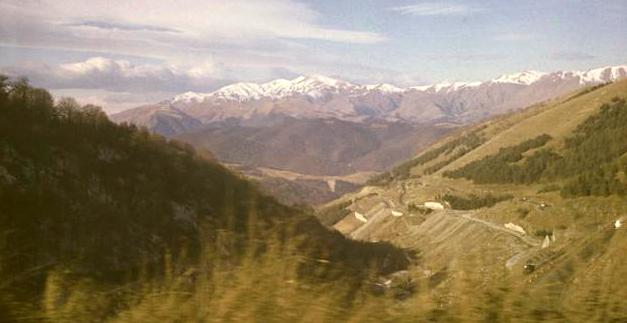

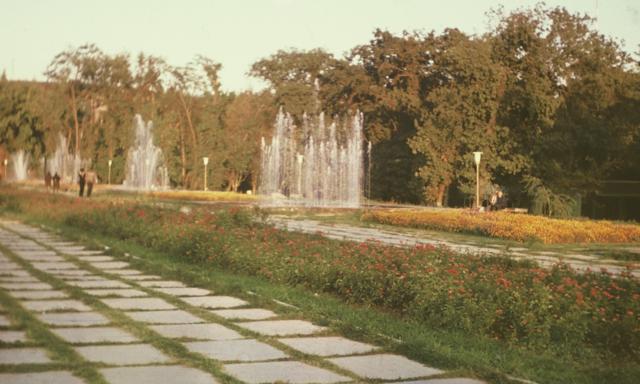
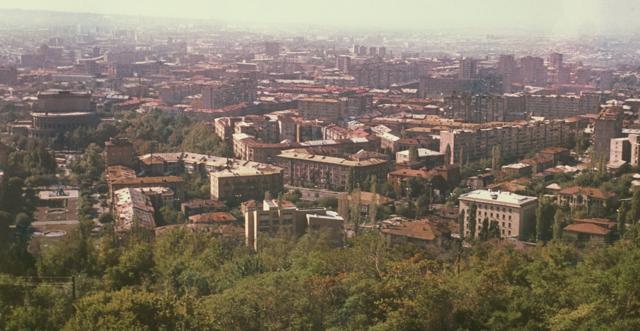

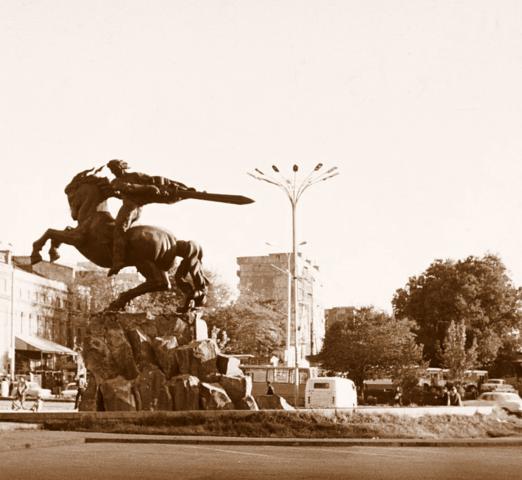
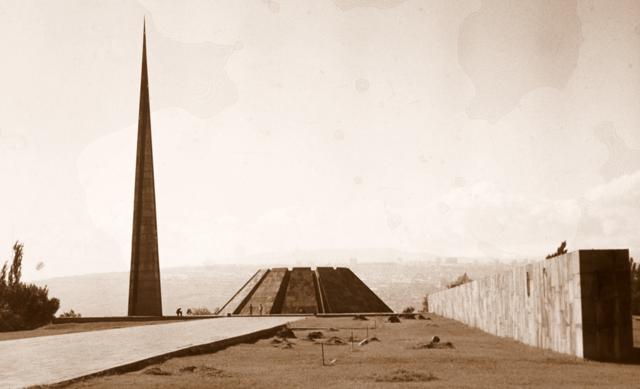
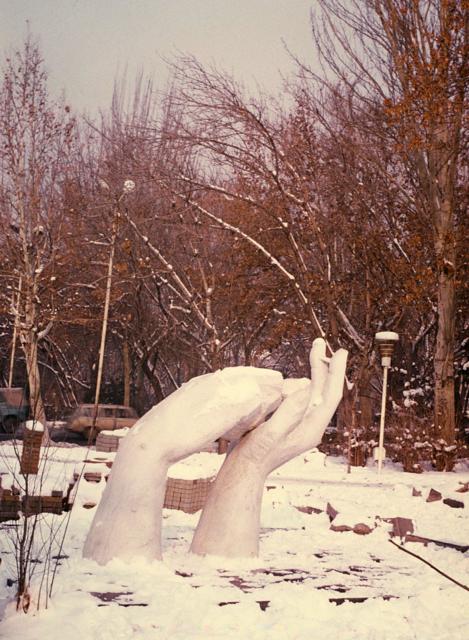
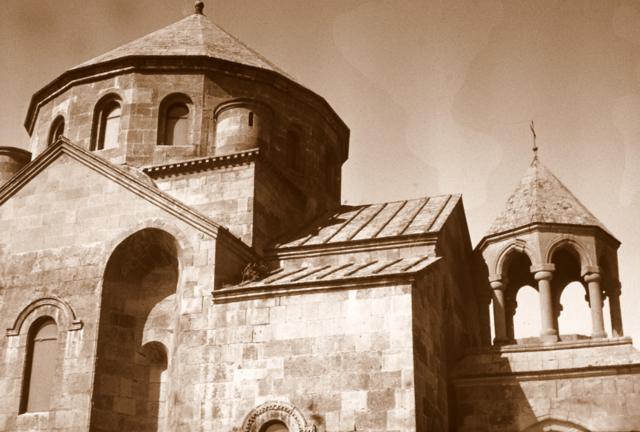
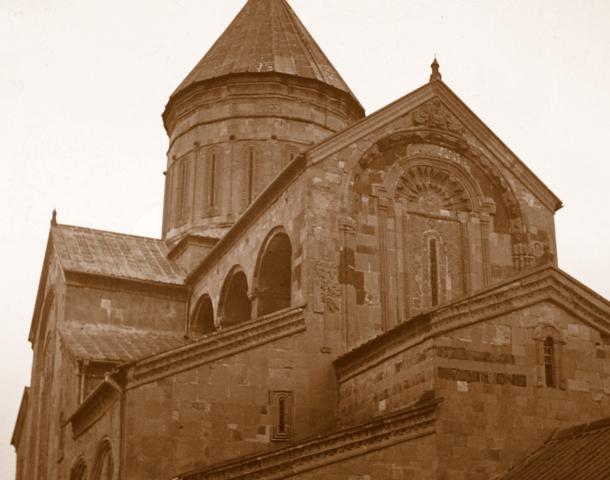
Hello, Traveling Hawk.
Lovely your works, full of joy.
Thank you World-wide LOVE, and your Support.
The prayer for all peace.
I wish You all the best.
Have a good weekend. from Japan ruma ❀
Thank you, ruma, for your comment!
Quite amazing artwork on those stones …
Quite so! Thanks, Wong.
Have a nice Sunday!
The stones are amazing. They have such life.
The city has a special character exactly because of this stone!
Thanks, Randy!
Hello Traveling Hawk,
nice to see pictures of Asia. The 2nd photo I also find very special with large colored stones. Funny you commented on the Hotel Armenia of a young hawk lol ….
Again a very nice travelogue with lovely photos.
Thank you, Helma! I already published the new post, about Tbilisi, the capital of Georgia. It was a great trip then. It would be interesting to see them today, in order to make comparisons.
Lovely churches, awful modern architecture…
Well, V.P., those are the Soviet model blocks of flats. Unfortunately we still have them too in many towns in Romania, including Bucharest, our capital. They are ugly but they solved – by then – the accommodation problem of the people brought from villages to towns, to work in the plants. Thanks for your comment!
Nu am ajuns la monumental eroilor pentru că era în renovare dar am văzut destule mănăstiri în și în afara Erevanului și nu în ultimul rând am vizitat Matenadaran (superbe manuscrise!). Piața Republicii pare neschimbată.
Erevanul anului 2013 a fost o surpriză foarte plăcută.
… iar acel hotel Armenia se numește azi … Mariott!
la timpuri noi, nume noi:)
In vazut cat de mult s-a schimbat atmosfera, e uimitor. Oare asa ne vad si pe noi strainii?!